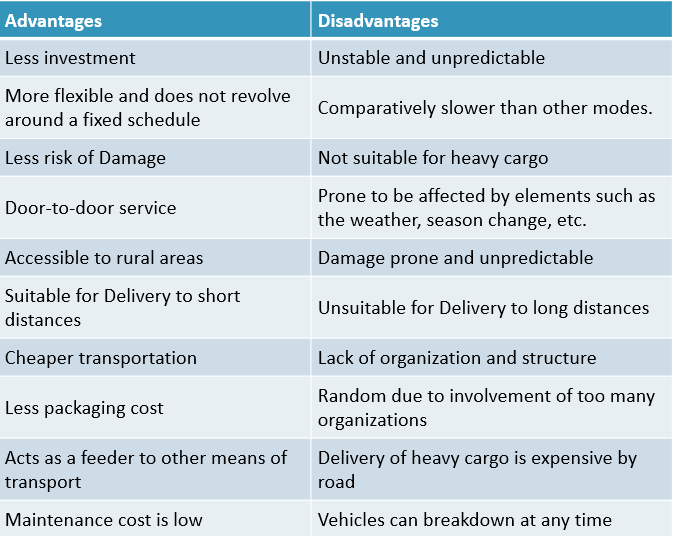Advantages and Disadvantages of Road Transport: Road transport is perhaps the mode of transportation people prefer the most in the case of supply chains for suppliers and businesses. Transport companies have scheduled delivery dates and even next-day delivery services if they have a high demand for goods. Most kinds of cargo, goods packed, goods containers, etc., which are scheduled for sea or air transportation have to be transported to and from the site via road transport.
Students can also find more Advantages and Disadvantages articles on events, persons, sports, technology, and many more.
What is Road Transport? Advantages and Disadvantages of Road Transport 2022
There are innumerable benefits of road transport in comparison to other modes of transport along with plenty of disadvantages of road transport in our country. Let us look at some of them.
- Advantages of Road Transport
- Disadvantages of Road Transport
- Comparison Table for Advantages and Disadvantages of Road Transport
- FAQs on Pros and Cons of Road Transport for Students

Advantages of Road Transport
Let us go through some of the key perks of road transport among the innumerable benefits from this mode of transportation that can help students and parents:
- Less investment: A relatively lower capital investment is standard in the case of road transport in comparison to other available modes of transport, such as railways, air transport, etc. The options other than road transport are much costlier. People have also seen that the cost of road construction, maintenance, and others require lower capital than that of railways or air transport. Since road construction is a part of the public sector and is under the primary jurisdiction of the Government and local authorities, people have to be a minor charge for using the roads.
- Door-to-door service: One of the greatest benefits of road transport is that it is the core lifeline of the transport industry due to its ability to provide door-to-door services. It is something no other mode of transportation has been able to achieve. Hence, it reduces cartage expenses, loading, unloading expenses, and other such associated feeder transport costs.
- Accessibility to rural areas: Road transport has the largest outreach to areas inaccessible by rail, water, or air. Therefore, people can transport cargo between towns or villages even if they do not have much connection to the neighboring areas as long as there is a road that is used for transportation.
- Suitable for short distances: It is the only type of transportation economically viable for short distances. It is not practical to use other modes of transportation for short distances. It is cost-effective and quicker to deliver the goods. People can handle the delay during handling, loading, unpacking, etc., if they load directly into a road vehicle. Overall, the intermediate handling costs and connectivity costs can be kept to a minimum. It is not plausible to use rail or air transportations for delivering to short distances.
- Flexible service: Through road transport, people can adjust the routes and timings to suit individual requirements. It gives a natural edge over all other methods of transportation that require rigid and inflexible time and route schedules.
- Lesser risk of Damage: There is always a possibility of damaging the goods during transit, but it is quite reduced due to the elimination of intermediate loading and handling of goods. Hence, if one needs to transport fragile goods, such as glassware, chinaware, etc., the one-time loading and unloading format typical in road transport is ideal.
- Less packaging cost: Compared to other transportations, road transport has a less complicated and less elaborate packaging technique. It does not require elaborate packaging, and therefore the packaging cost is much lower.

Disadvantages of Road Transport
Since everything has a flip side, there are some disadvantages to the amazing merits of road transportation. The disadvantages are as follows.
- Vulnerability to seasons and weather: Road transportation is not immune to the weather or seasonal changes. For example, the roads become inaccessible during floods, rain, and snow. The roads become unsafe for deliveries, and it is less reliable than rail transportation in this case.
- Breakdown and accident-prone: There are numerous accidents on the roads, and there is always a high risk of accident or breakdown in case of road transport. Hence, it is not predictable or safe compare to rail.
- Not suitable for long-distance and heavy cargo: Heavy cargo is difficult to handle and transport through road transport. There is always a chance of overloading and accidents in this case, and such accidents can prove to be expensive.
- Slow: Unlike rail, air, or water transport, road transports are slower. Hence, it is a substantial disadvantage and a deterrent.
- Lack of structure and organization: As a method of transportation, it is much less organized than its counterpart, rail, water, and air transport. These are way more structured. Furthermore, since it is irregular, the rates can vary randomly. Due to the multiple options in the industry, it is unstable and unpredictable.
Advantages And Disadvantages Of Road Transport In Tabular Form
| Advantages | Disadvantages |
|---|---|
| 1. Door-to-Door Service | 1. Traffic Congestion |
| 2. Flexibility and Convenience | 2. Weather and Road Conditions |
| 3. Lower Capital Investment | 3. Accidents and Safety Risks |
| 4. Wide Coverage Area | 4. Environmental Impact |
| 5. Faster Delivery | 5. Dependence on Fossil Fuels |
Comparison Table for Advantages and Disadvantages of Road Transport
| Advantages | Disadvantages |
| Less investment | Unstable and unpredictable |
| More flexible and does not revolve around a fixed schedule | Comparatively slower than other modes. |
| Less risk of Damage | Not suitable for heavy cargo |
| Door-to-door service | Prone to be affected by elements such as the weather, season change, etc. |
| Accessible to rural areas | Damage prone and unpredictable |
| Suitable for Delivery to short distances | Unsuitable for Delivery to long distances |
| Cheaper transportation | Lack of organization and structure |
| Less packaging cost | Random due to involvement of too many organizations |
| Acts as a feeder to other means of transport | Delivery of heavy cargo is expensive by road |
| Maintenance cost is low | Vehicles can breakdown at any time |

Analyzing more topics in the context of advantages and disadvantages is a great way to obtain knowledge. Hence, knowing about more topics such as this will help to increase general awareness for international competitive exams in no time.
FAQ’s on Pros and Cons of Road Transport for Students
Question 1.
How does road transportation benefit the industry?
Answer:
Some of the benefits of road transport for the industry and the economy are as follows.
- It is more flexible and easily accessible.
- It is more cost-effective than other transports such as air and rail.
- It does not involve much tax as in the other transports.
- It acts as the connector or the feeder between other modes of transportation since it is the only way people can achieve door-to-door services.
Question 2.
Why is road transportation important?
Answer:
Road transports are at the heart of the transport industry since it provides us with door-to-door services. Unlike other methods, it is the process where people don’t need to step out of their homes to buy essential daily items.
Besides, due to its comparatively low cost of packaging, tax, and operating costs, most industries have to rely on it for its smooth functioning. Without road transports, the economy would fall since it will not be possible to meet the demands of the people, and the supply chain would break.
Question 3.
How can road transport be improved?
Answer:
Road transport is a relatively substantial source of pollution, and the emissions continue to rise with the increase of delivery vehicles running on petrol and diesel. If road transport vehicles can switch from petrol or diesel-run motors to electric or hybrid-electric cars, the average emissions will decrease, and the environmental conditions can improve. Hence, the industry should promote the use of plug-in hybrid electric vehicles in place of the traditional fuel-run ones.
